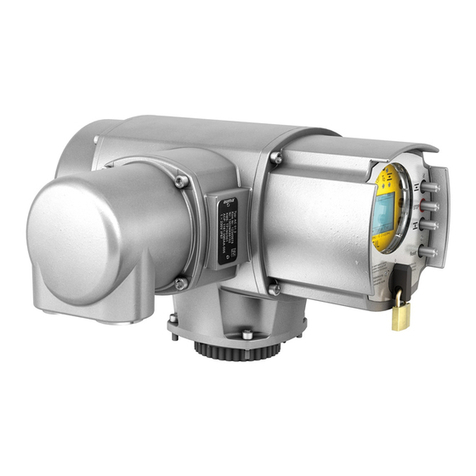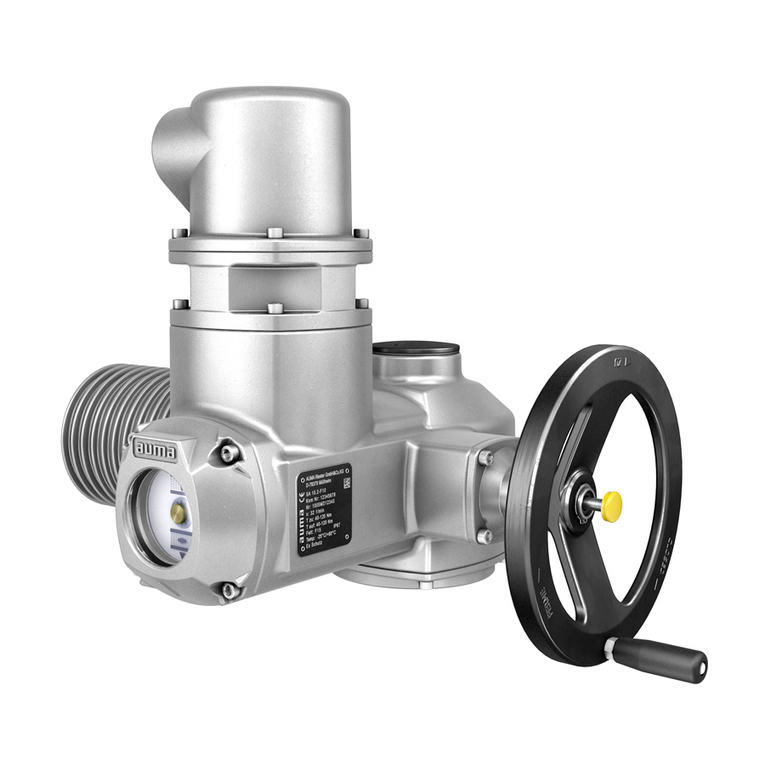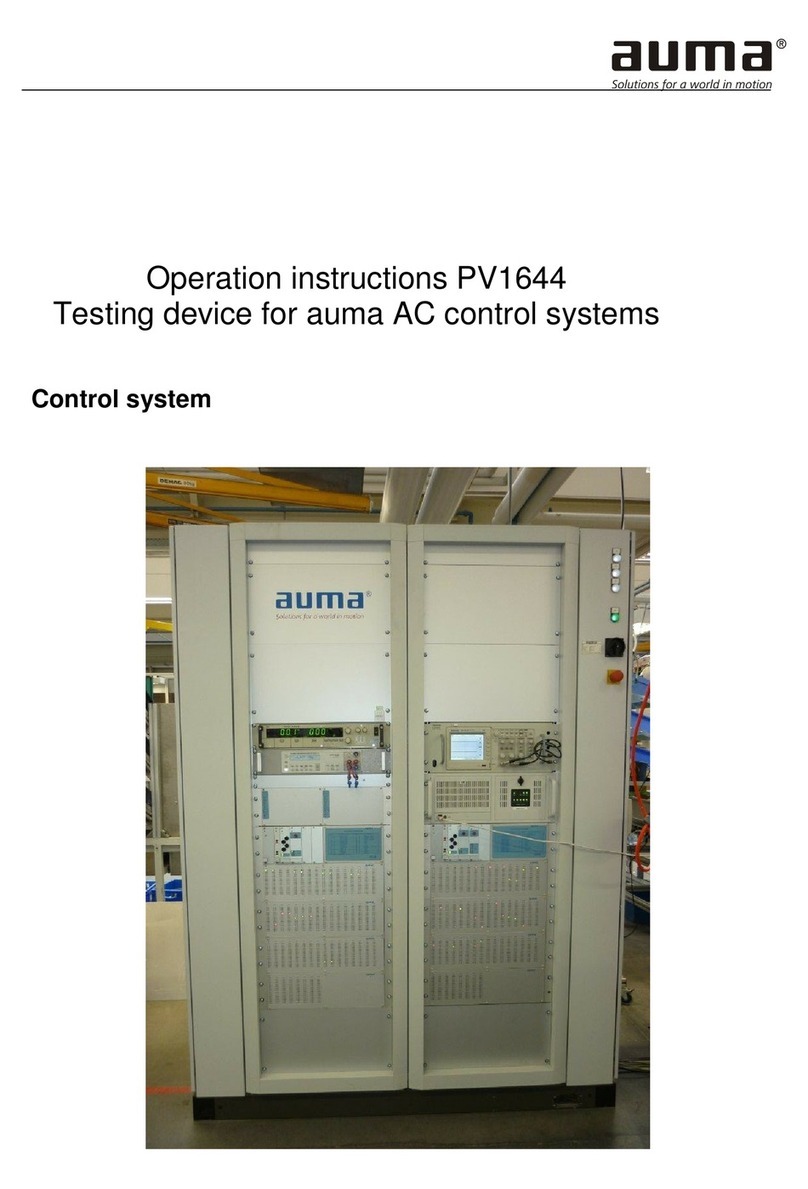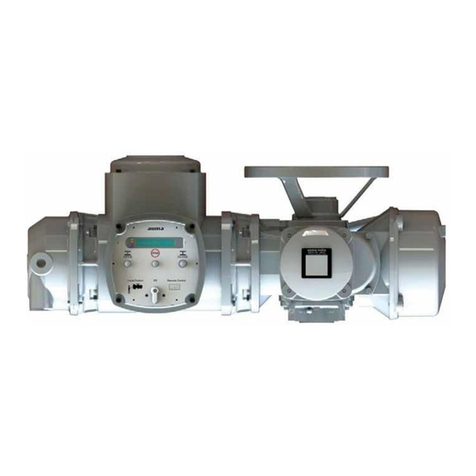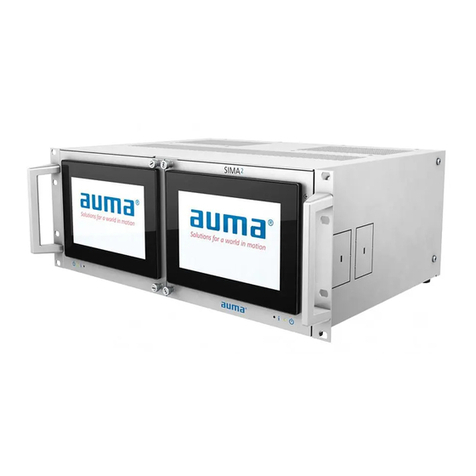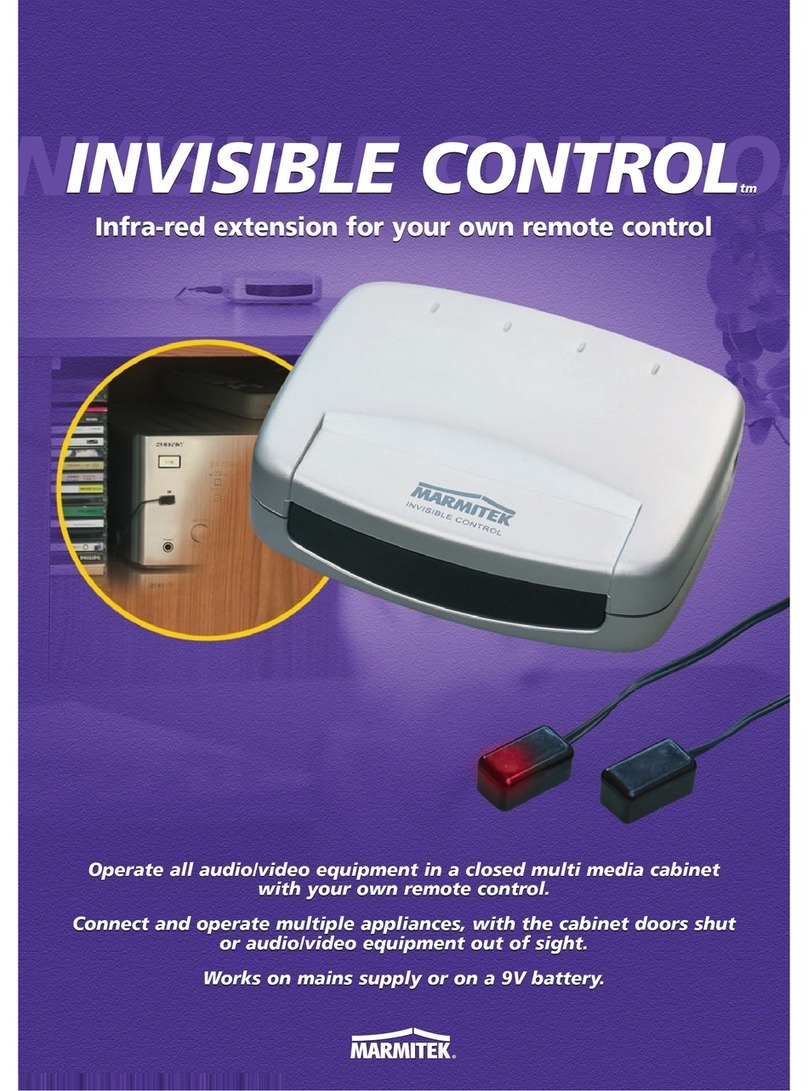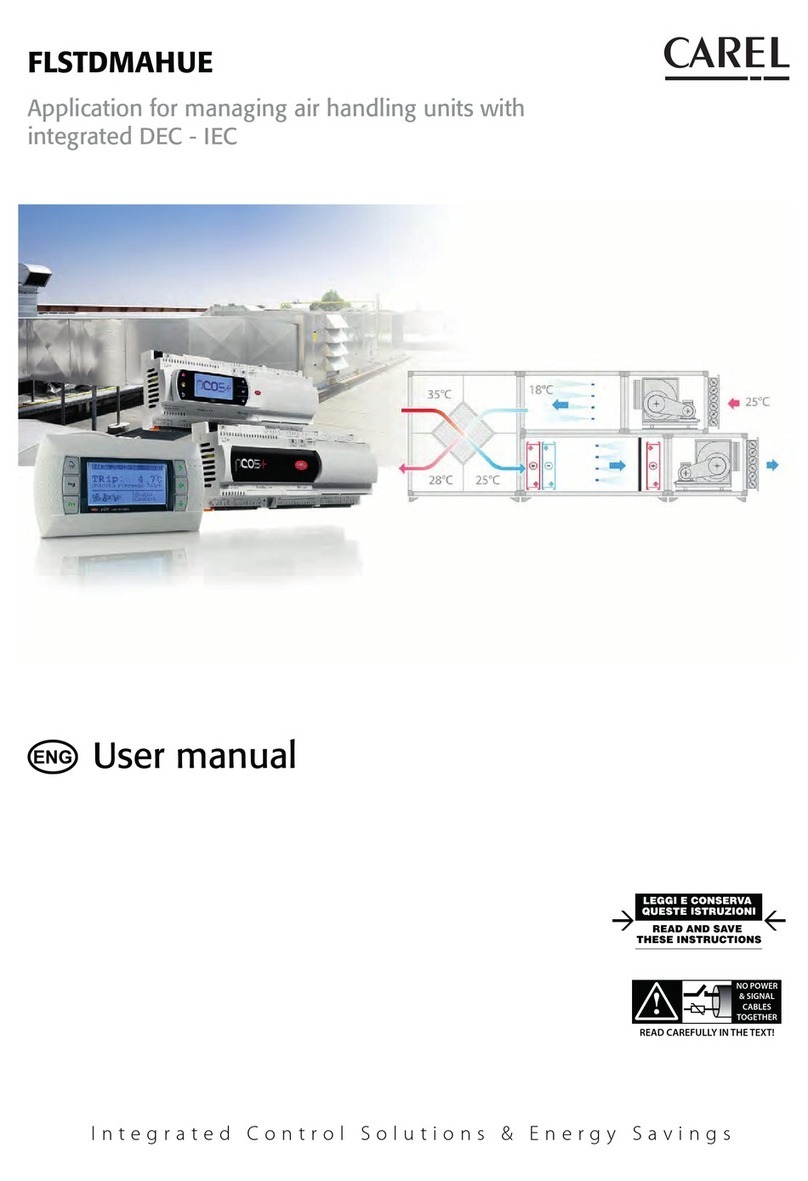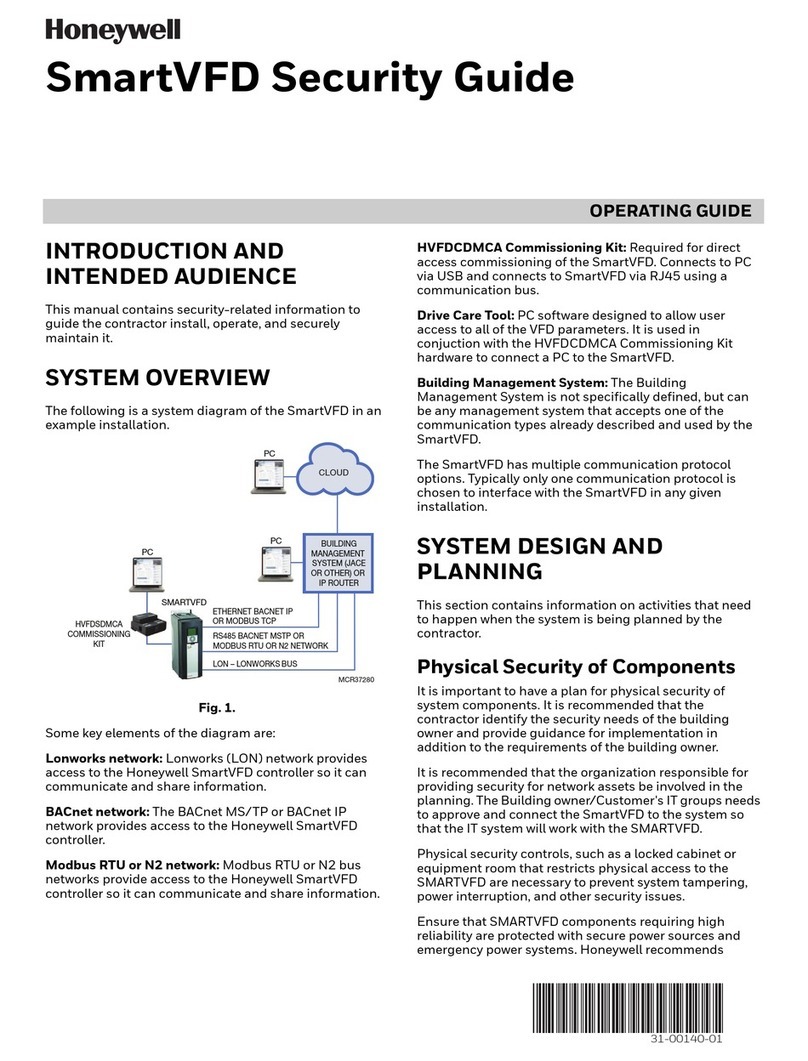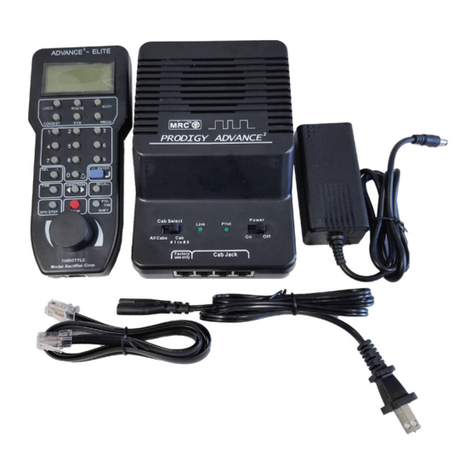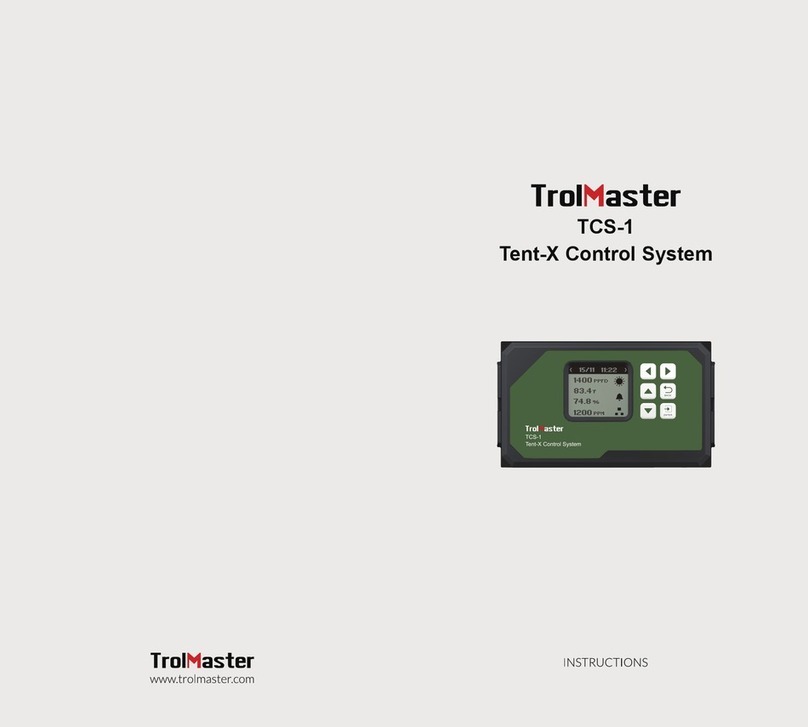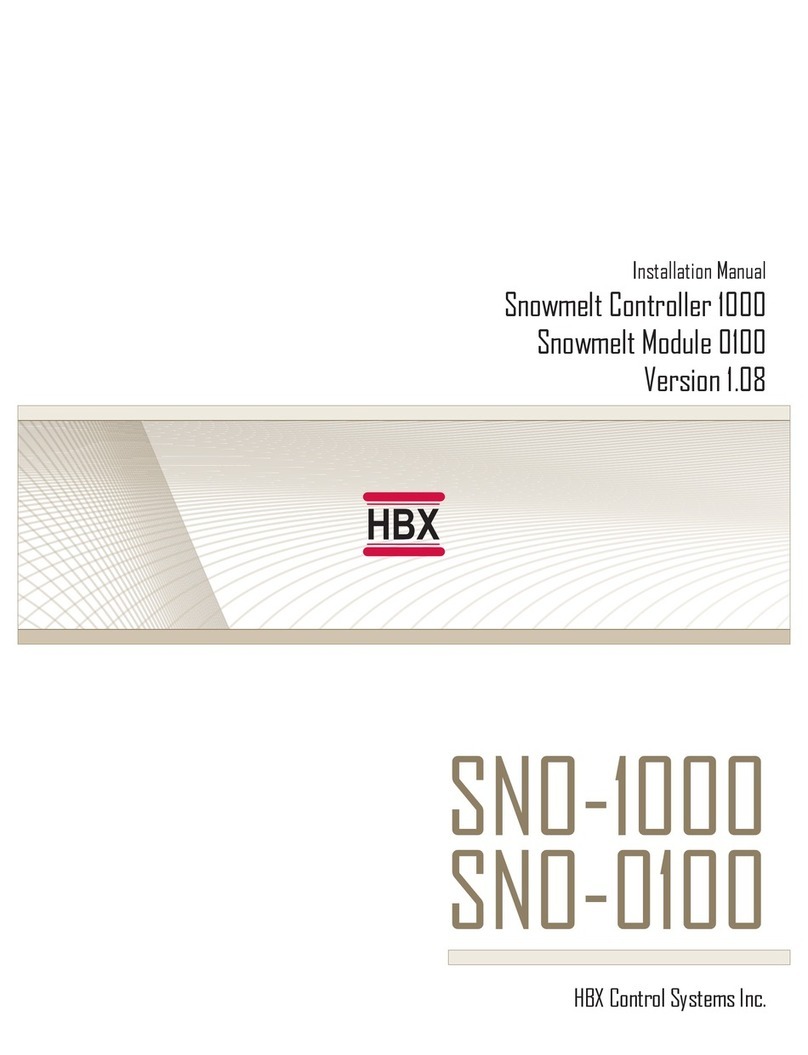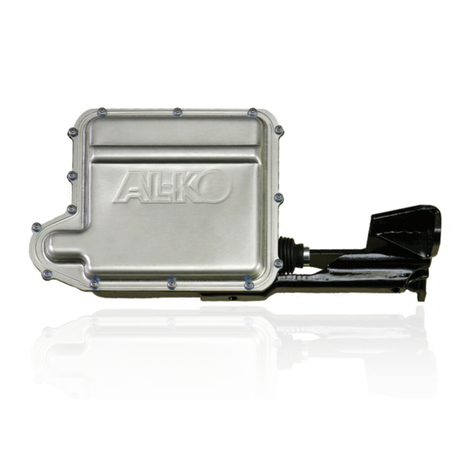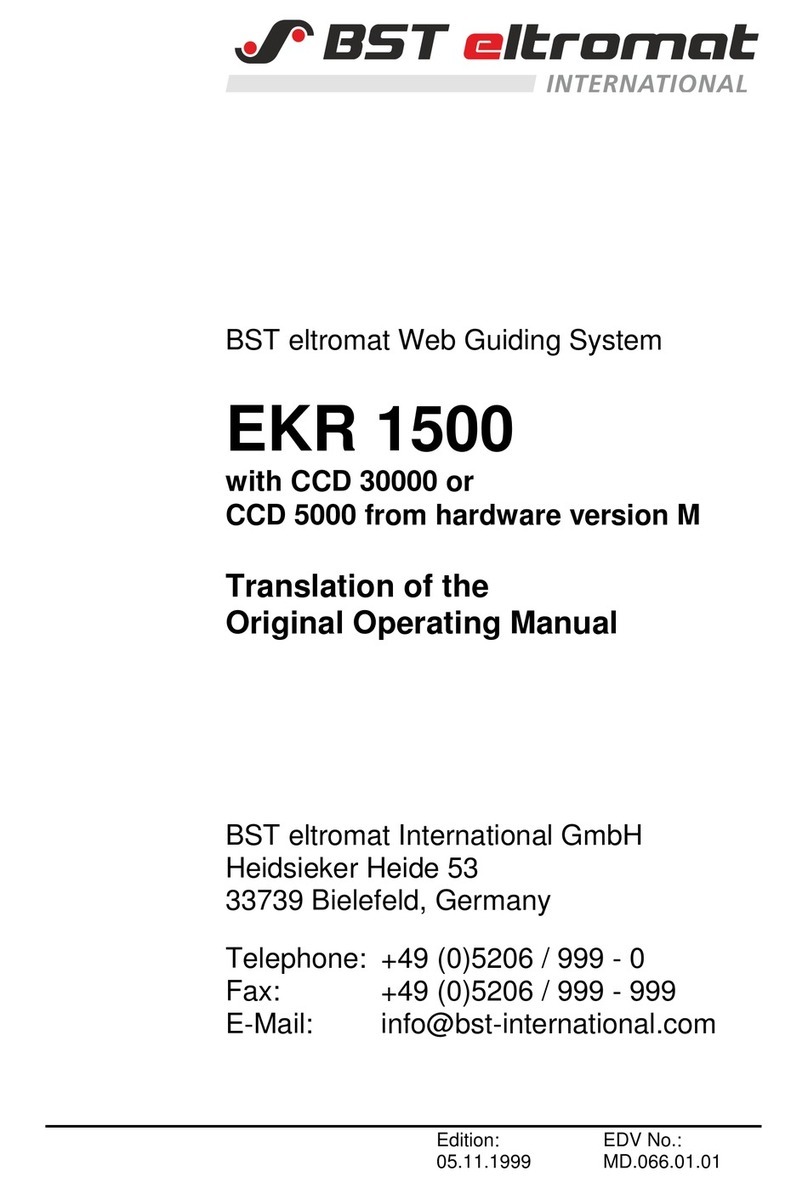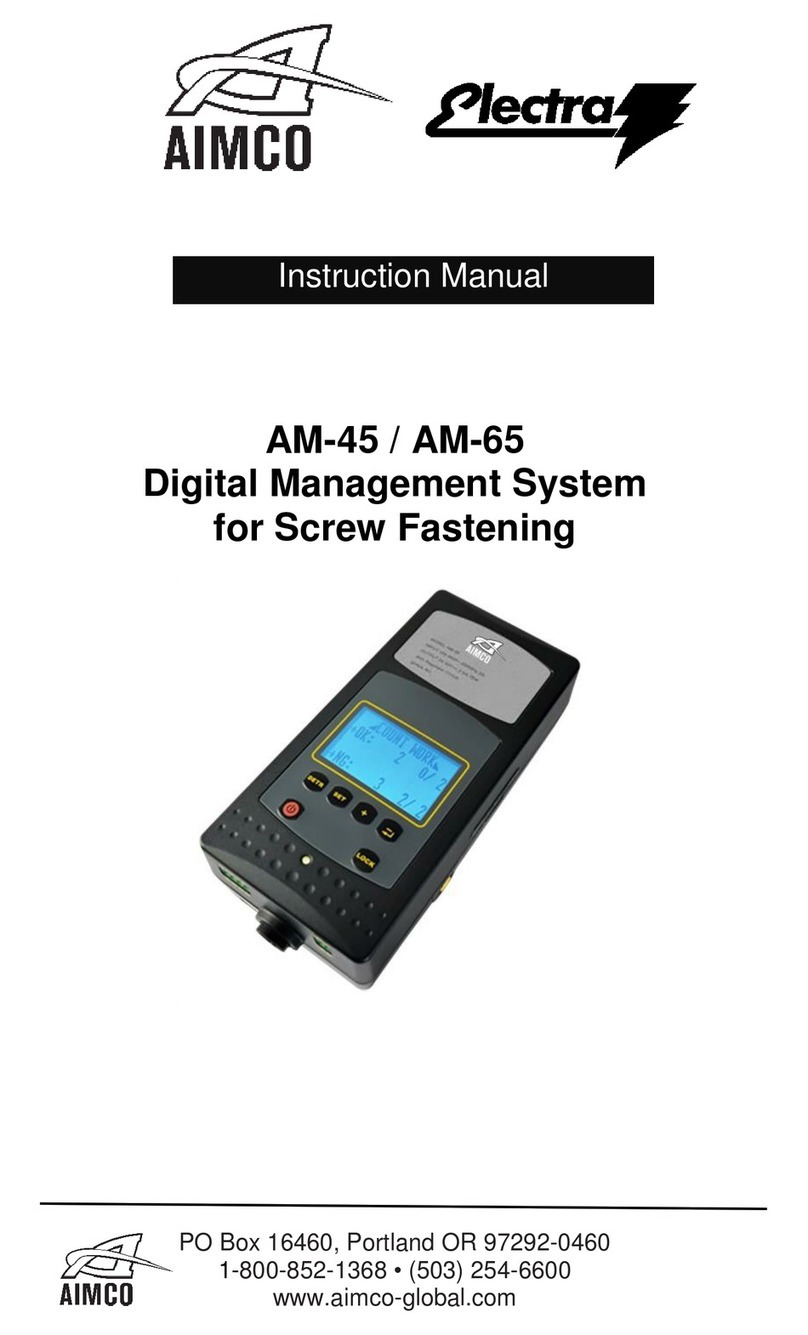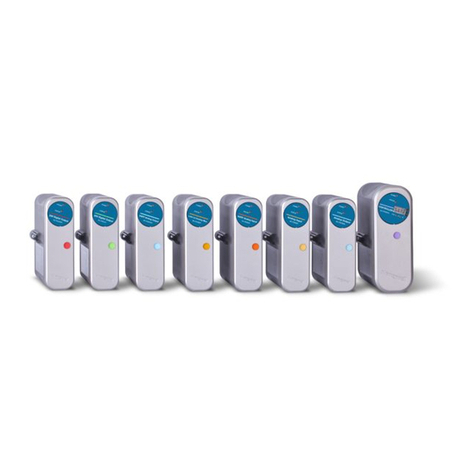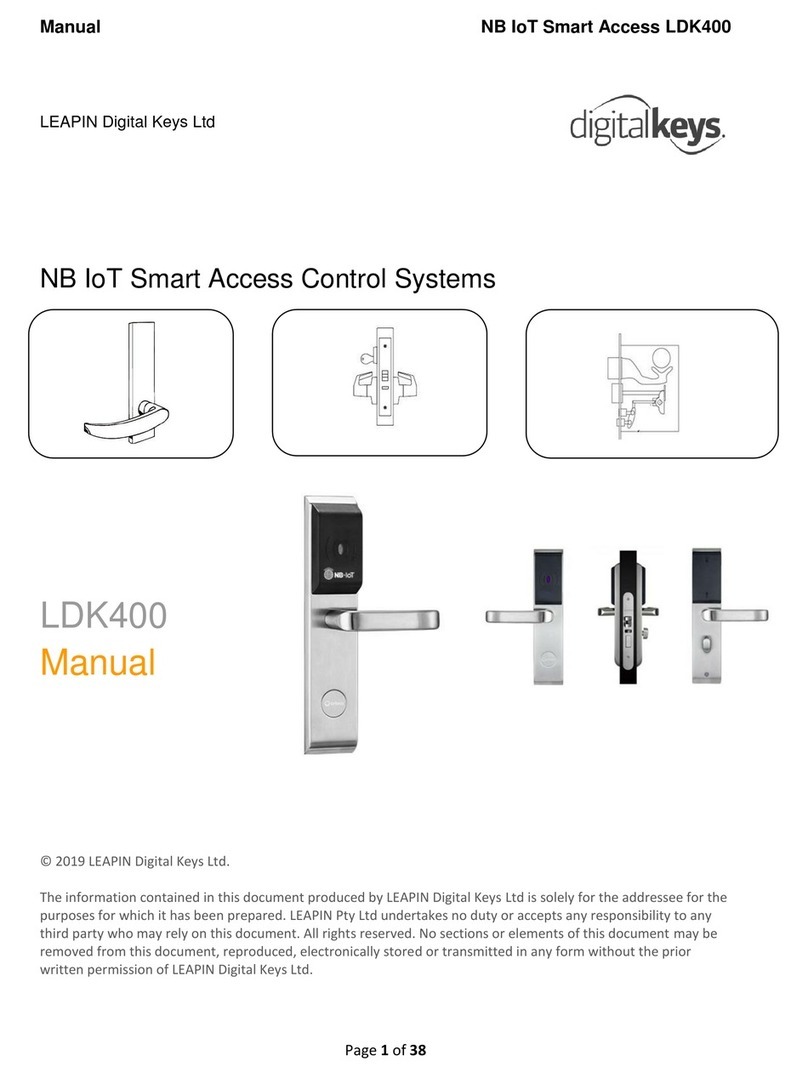AUMA AC(V) 01.2 User manual

Actuator controls
AC(V) 01.2/AC(V)ExC 01.2
HART
Device integrationManual

Read operation instructions first.
●Observe safety instructions.
Purpose of the document:
This document contains information for the commissioning staff of the distributed control system and DCS software
engineers.This document is intended to support actuator integration into the DCS via the communication interface.
Reference documents:
●Operation instructions (Assembly and commissioning) for the actuator
●Manual (Operation and setting) AC 01.2 actuator controls HART
Reference documents can be downloaded from the Internet (www.auma.com) or ordered directly from AUMA
(refer to <Addresses>).
Table of contents Page
41. Safety instructions................................................................................................................. 41.1. Prerequisites for the safe handling of the product 51.2. Range of application 51.3. Warnings and notes 51.4. References and symbols
72. General information on HART............................................................................................... 72.1. General information on HART 82.2. Basic characteristics 82.3. Communication technology 82.4. Data exchange 92.5. Topology - HART device network configuration 112.6. HART communication cable 122.7. Requirements on power supplies 122.8. Control & HART device categories 142.9. Protective functions 142.10. Device types
153. Commissioning...................................................................................................................... 153.1. Introduction 153.2. Parameter setting 163.3. Bus address (slave address) 173.4. Communication start 173.5. HART commands 173.6. HART communication monitoring 183.7. Calibration 4 –20 mA of HART interface 183.7.1. Adjustment of loop current or current trim 183.7.2. Range adaptation of process variables (Dynamic Variables)
204. Description of the data interface.......................................................................................... 204.1. Supported HART commands 204.1.1. Universal Commands 204.1.2. Common Practice Commands 204.1.3. Device Specific Commands 214.2. Dynamic variables 214.3. Device variables 214.3.1. Description of input data (signal from actuator)
2
Actuator controls
Table of contents AC(V) 01.2/AC(V)ExC 01.2 HART

264.3.2. Description of the output data (operation commands) 284.4. Device specific commands 284.4.1. Input data (process representation input) –signals from the actuator 334.4.2. Output data (process representation output) - operation commands 364.5. Status information 364.5.1. Description of status information 424.6. Further information on the data interface 424.6.1. Table of units 424.6.2. Unsupported functions (HART commands) 434.6.3. Further device data 434.6.3.1. Sampling Rates 434.6.3.2. Power Up 434.6.3.3. Reset 434.6.3.4. Self-test 434.6.3.5. Response times (Command Response Times) 434.6.3.6. Long Messages 434.6.3.7. Non-volatile memory 434.6.3.8. Modes 434.6.3.9. Write protection 444.6.3.10. Attenuation
455. Description of HART board................................................................................................... 465.1. Indications (indication and diagnostic LEDs)
476. Corrective action.................................................................................................................... 476.1. Troubleshooting 486.2. Diagnostics
497. Technical data......................................................................................................................... 497.1. HART interface
518. Appendix................................................................................................................................. 518.1. Performance features 518.2. Wiring diagram, example of “Actuator”device category, setpoint via AIN1 528.3. Wiring diagram, example of “Current Output ”device category, actual position value via
AOUT1 528.4. Parameters
70Index........................................................................................................................................
3
Actuator controls
AC(V) 01.2/AC(V)ExC 01.2 HART Table of contents

1. Safety instructions
1.1. Prerequisites for the safe handling of the product
Standards/directives The end user or the contractor must ensure that all legal requirements, directives,
guidelines, national regulations and recommendations with respect to assembly,
electrical connection, commissioning and operation are met at the place of installation.
They include among others standards and directives such as IEC 60079 “Explosive
atmospheres".
●Part 14: Electrical installations design, selection and erection.
●Part 17: Electrical installations inspection and maintenance.
Safety instructions/
warnings All personnel working with this device must be familiar with the safety and warning
instructions in this manual and observe the instructions given. Safety instructions
and warning signs on the device must be observed to avoid personal injury or property
damage.
Qualification of staff Assembly, electrical connection, commissioning, operation, and maintenance must
be carried out by suitably qualified personnel authorised by the end user or contractor
of the plant only.
Prior to working on this product, the staff must have thoroughly read and understood
these instructions and, furthermore, know and observe officially recognised rules
regarding occupational health and safety.
Work performed in potentially explosive atmospheres is subject to special regulations
which have to be observed.The end user or contractor of the plant is responsible
for respect and control of these regulations, standards, and laws.
Electrostatic charging Highly efficient charge generating processes (processes more efficient than manual
friction) on the device surface must be excluded at any time, since they will lead to
propagating brush discharges and therefore to ignition of a potentially explosive
atmosphere.
This also applies to fireproof coatings or covers available as an option.
Ignition dangers Gearboxes were subjected to an ignition hazard assessment in compliance with the
currently applicable standard according to ISO 80079-36/ -37.Hot surfaces,
mechanically generated sparks as well as static electricity and stray electric currents
were identified and assessed as major potential ignition sources.Protective measures
to prevent the likelihood that ignition sources arise were applied to the gearboxes.
This includes in particular lubrication of the gearbox, the IP protection codes and the
warnings and notes contained in these operation instructions.
Commissioning Prior to commissioning, imperatively check that all settings meet the requirements
of the application. Incorrect settings might present a danger to the application, e.g.
cause damage to the valve or the installation.The manufacturer will not be held
liable for any consequential damage. Such risk lies entirely with the user.
Operation Prerequisites for safe and smooth operation:
●Correct transport, proper storage, mounting and installation, as well as careful
commissioning.
●Only operate the device if it is in perfect condition while observing these instruc-
tions.
●Immediately report any faults and damage and allow for corrective measures.
●Observe recognised rules for occupational health and safety.
●Observe national regulations.
●During operation,thehousingwarmsupandsurfacetemperatures>60 °C may
occur.To prevent possible burns, we recommend checking the surface temper-
ature prior to working on the device using an appropriate thermometer and
wearing protective gloves.
4
Actuator controls
Safety instructions AC(V) 01.2/AC(V)ExC 01.2 HART

Protective measures The end user or the contractor are responsible for implementing required protective
measures on site, such as enclosures, barriers, or personal protective equipment
for the staff.
Maintenance To ensure safe device operation, the maintenance instructions included in this manual
must be observed.
Any device modification requires prior written consent of the manufacturer.
1.2. Range of application
AUMA actuator controls are exclusively designed for the operation of AUMA actuators.
Other applications require explicit (written) confirmation by the manufacturer.The
following applications are not permitted, e.g.:
●motor control
●pump control
No liability can be assumed for inappropriate or unintended use.
Observance of these operation instructions is considered as part of the device's
designated use.
1.3. Warnings and notes
The following warnings draw special attention to safety-relevant procedures in these
operation instructions, each marked by the appropriate signal word (DANGER,
WARNING, CAUTION, NOTICE).
Indicates an imminently hazardous situation with a high level of risk. Failure
to observe this warning results in death or serious injury.
Indicates a potentially hazardous situation with a medium level of risk.Failure
to observe this warning could result in death or serious injury.
Indicates a potentially hazardous situation with a low level of risk. Failure to
observe this warning could result in minor or moderate injury. May also be
used with property damage.
Potentially hazardous situation. Failure to observe this warning could result
in property damage. Is not used for personal injury.
Safety alert symbol warns of a potential personal injury hazard.
The signal word (here: DANGER) indicates the level of hazard.
1.4. References and symbols
The following references and symbols are used in these instructions:
Information The term Information preceding the text indicates important notes and information.
Symbol for CLOSED (valve closed)
Symbol for OPEN (valve open)
Via the menu to parameter
Describes the menu path to the parameter.When using the push buttons of local
controls, the required parameter can be quickly found on the display. Display texts
are shaded in grey: Display.
➥Result of a process step
Describes the result of a preceding process step.
5
Actuator controls
AC(V) 01.2/AC(V)ExC 01.2 HART Safety instructions

Warning signs at the device
The following warning signs can be attached to the device.
General warning sign
General warning of a danger zone.
Hot surface
Warning of hot surfaces, e.g.possibly caused by high ambient temperatures or strong
direct sunlight.
Electrical voltage
Hazardous voltage! Warning of electric shock. At some devices, the warning sign
additionally includes a time interval, e.g. 30 s. Once power supply is switched off,
you will have to wait for the indicated period. Only then may the device be opened.
6
Actuator controls
Safety instructions AC(V) 01.2/AC(V)ExC 01.2 HART

2. General information on HART
2.1. General information on HART
HART (Highway AddressableRemoteTransducer)isanopen communication protocol
allowing bidirectional data exchange between DCS and field devices on the basis
of analogue 4 –20 mA signals.It simultaneously provides digital transmission of
diagnostic, maintenance and process information from field devices to host (master)
systems in addition to analogue process value transmission.
HART is not a typical fieldbus but rather a protocol variant of digital field
communication based on analogue signal transmission while comprising many
functions of a fieldbus system.
HART has been part of the international fieldbus standards of IEC 61158 and IEC
61784 (CPF 9) since 2007.The Wireless HART variant was specified in 2009.
HART characteristics
HART offers a wide range of services and functions, with particular advantages when
combined with smart field devices:
●Point-to-point wiring with cable lengths up to 3,000 m
●Multidrop topology (line topology) available as an option (number of participants
typically ≤8).
●Using known conventional 4 –20 mA infrastructure for
- Remote access to inaccessible devices.
- Device configuration for field device commissioning.
- Device and fault diagnostics during active operation.
- Asset Management for field devices.
- Transmission of additional process values from and to the field device.
- Transmission of Primary Variable (PV) as precise digital process value
for adjustment/validation with the 4 –20 mA signal.
●Device integration within DCS using standardised technologies (e.g.EDD)
●Application facilities in explosive atmospheres
●Standardised and simple commissioning procedures (loop test and signal cal-
ibration)
Use and benefits for actuators
Figure 1: Operation commands and feedback signals
7
Actuator controls
AC(V) 01.2/AC(V)ExC 01.2 HART General information on HART

Figure 2: Services and diagnostic data
2.2. Basic characteristics
The HART interface superimposes and transmits all actuator parameters adjustable
and legible via local controls (e.g.for commissioning, diagnostics, status signals) as
digital instruction (command = write parameter, request = read parameter) to an
analogue input or output.
Furthermore, digital control commands (e.g.OPEN, STOP and EMERGENCY) can
be transmitted for actuator control.Within the device, these HART commands are
reconverted into binary control commands. In turn and on instruction, the actuator
sends the status of its own binary signal outputs, the actual value/setpoint at analogue
inputs/outputs as well as the acknowledgements on parameter changes as digital
telegram via the integral HART modem to the DCS or PLC.
2.3. Communication technology
For data exchange, HART always requires an analogue current signal 4 –20 mA
onto which the higher frequency digital HART signals are superimposed via FSK
modem (Frequency Shift Keying).Both frequencies 1,200 Hz and 2,200 Hz of the
superimposed signal correspond to the logic states 1 and 0.
Figure 3: HART signal
2.4. Data exchange
In HART applications, distinction is made between the DCS/PLC (master) and the
field device (slave). For communication between DCS/PLC and field devices, HART
uses a half-duplex system for request-response communication. Depending on the
8
Actuator controls
General information on HART AC(V) 01.2/AC(V)ExC 01.2 HART

actual process data length, complete date exchange whereby the master sends an
instruction telegramand the slave issues responses takesup to 0.5 seconds assuming
a transmission speed/baud rate of 1,200 bit/s. For point-to-point configuration, 2 to
3 telegrams can be exchanged.An average transmission time of 13 ms is accounted
for each process byte.
The HART protocol supports two hosts (masters), a primary master is generally a
distributed control system, the secondary master is typically a handheld terminal or
a laptop with HART modem for field configuration.Both hosts can act simultaneously.
After each transaction, representing the data exchange between host and field device,
one of the two masters can take over communication within a fixed and assigned
time window.
Figure 4: HART data transaction with request and response telegram
2.5. Topology - HART device network configuration
HART devices can operate in various network configurations.The most frequent
configuration is point-to-point connection.For this application, the master is only
connected to one HART field device.
Point-to-point connection
The following figure illustrates the point-to-point connection of AC .2 with HART
“Actuator”device category.PLC defines a setpoint via the 4 –20 mA analogue signal.
The signal power supply is outside the actuator.
Figure 5: Example of point-to-point connection
HART data is modulated onto the 4 –20 mA signal via HART modem.Generally,
the controllers (masters) send and receive a modulated voltage signal where the
fielddevices(slaves) send theirmessages via superimposed currents.HART current
signals are converted and inverted into the required voltage signals by a resistor
available within the current loop (internal resistance of power supply, line resistance,
9
Actuator controls
AC(V) 01.2/AC(V)ExC 01.2 HART General information on HART

input resistance of actuator, etc.).The total resistance of the current loop including
the cable resistance must amount to minimum 230 Ωand maximum 1,100 Ω. In
case the available resistance of the current loop is too low, a so-called communication
resistor must be integrated in series.Generally, communication resistors are rated
at approx. 250 Ω.
Device categories AC .2 actuator controls distinguish two HART variants, the device categories
“Actuator”and “Current Output”.When ordering AC .2 actuator controls, the type of
HART communication channel must be specified, either 4 –20 mA input or 4 –20
mA output.
When using AC . 2 device category “Actuator”, no further communication resistor is
required within the current loop for communication with the controller, since the HART
current input already offers a resistance of 250 Ω(low impedance).
Figure 6: Example wiring of HART device category “Actuator”
Example wiring of HART device category “Current Output”.The actuator issues the
actual value via the 4 –20 mA analogue signal, the signal power supply is contained
within the actuator.
Figure 7: Example wiring of HART device category “Current Output”
The actuator current output has a high internal impedance of approx. 40 kΩ(high
impedance).When using this concept and depending on the input impedance of the
used current input, an additional communication resistor might be required.
HART multidrop
HART allows for implementation of rarely used line topologies, comparable to the
classical fieldbus applications, called multidrop.For this operation mode, a so-called
polling address must be assigned to every single of maximum 8 HART devices,
arranged in parallel, preferably within the range of 1 –15.This operation mode does
not allow for analogue signal transmission.Communication is only digital and
sequential to every single end device.
The HART multidrop mode is provided for AC .2 actuator controls in variant “Current
Output”(high impedance).
10
Actuator controls
General information on HART AC(V) 01.2/AC(V)ExC 01.2 HART

Figure 8: HART multidrop
Characteristics of HART multidrop:
●Very slow request rate –0.5 seconds per device in sequential order
●Purely digital communication
●Address assignment required
●≤8 devices per line
●Useinputs/outputs with highimpedance(referto <Technicaldata> input imped-
ance/output impedance)
●Output current is set to 4 mA
Settings for multidrop
Settings at local controls of actuator controls (menu operation via push buttons):
1. Deactivate HART parameter Loop current mode:
Indication on display:
Customer settings M0041
HART M1238
Loop current mode M1254
2. Set HART polling address unequal to 0:
Indication on display:
Customer settings M0041
HART M1238
Address M1253
Information
These settings can also be performed via a Bluetooth device (via PC, laptop, ...) and
the AUMA CDT service software or the AUMA Assistant App.
2.6. HART communication cable
The correct selection of HART communication cable can be crucial. It depends on
length, cross section as well as ambient conditions if foreign signals might cause
interferences.The majority of all available field installations meets the HART
communication requirements without further adaptation requirement.
Installation criteria:
●Total current loop impedance including line impedance min.230 Ω, max.1,100
Ω.
●For disturbances and long cables, two-wire cables of min.0.5 mm² or AWG 20
with twisted wire pairs and common shielding are recommended.
●Unshielded cables with 0.2 mm or AWG 24 are sufficient when dealing with
short distances < 100 m.
For further information, refer to HART installation guidelines.
11
Actuator controls
AC(V) 01.2/AC(V)ExC 01.2 HART General information on HART

2.7. Requirements on power supplies
Power supplies used in 4 –20 mA HART installations must meet the following
specifications:
●Maximum residual ripple: (47 –125 Hz) = 0.2 V p-p
●Maximum sweep: (500 Hz –10 kHz) = 1.2 mV rms
●Maximum series impedance: (500 Hz –10 kHz) = 10 Ω
2.8. Control & HART device categories
AC .2 actuator controls distinguish two HART variants, the device categories
“Actuator”and “Current Output”.When ordering actuator controls, the type of HART
communication channel must be specified:4 –20 mA input or 4 –20 mA output.
Irrespective of the digital HART communication, all further binary and analogue inputs
and outputs remain available.Consequently, it is quite possible to operate the actuator
via binary control signals (e.g.OPEN, STOP, CLOSE and EMERGENCY) or via
analogue 4 –20 mA setpoint and to send binary as well as analogue signals via the
respective outputs to the DCS while HART communication is used for commissioning
and diagnostics.
Basically, the control commands can be exclusively sent from one defined interface.
The operator must specify which interface is to be used to execute this function.In
this respect, the device variants “Actuator”and“Current Output”differ.A more detailed
description of both variants is available hereafter.
"Actuator”device category
●HART communication and analogue setpoint definition via 4 –20 mA input
●Input impedance: 250 Ω(HART low impedance)
●Control commands via binary control inputs (option)
●Feedback signal on position value via separate 4 –20 mA output (option)
Operational settings for“Actuator”:
In typical applications, the actuator is controlled by means of analogue 4 –20 mA
setpoint via HART analogue input AIN. If this setpoint is to be controlled via HART,
parameter Loop current modeM1254 must be deactivated. Settings can be made
using all available interfaces, provided the corresponding access rights are available.
(parameter Customer settings M0041 > HART M1238 > Loop current mode M1254)
If parameter Loop current mode is deactivated, control commands can be directly
executed via HART. Analogue input current does no longer have an impact on the
setpoint.
Digital control inputs OPEN, STOP, CLOSE, EMERGENCY (refer to wiring
diagram) are deactivated, unless as they are activated via I/O INTERFACE input.
If these discrete inputs are activated, exclusive control on actuator controls are
assumed by these inputs.
Summary of “Actuator”control types:
●Parameter Loop current mode M1254 activated:
Analogue 4 –20 mA control signal for position setpoint
●Parameter Loop current mode M1254 deactivated:
Digital HART commands for position setpoint (0 –100.0 %) or for discrete op-
eration in directions OPEN and CLOSE
12
Actuator controls
General information on HART AC(V) 01.2/AC(V)ExC 01.2 HART

Figure 9:Wiring diagram, example of “Actuator”device category
Device category“Current Output”
●HART communication and analogue actual value/position feedback via 4 –20
mA output
●Output impedance: 40 kΩ(HART high impedance)
●Control commands via binary control inputs (option)
●Setpoint definition via separate 4 –20 mA analogue input (option)
When selecting the “Current Output”variant, it must be considered that the 4 –20
mA HART output is fed by the internal power supply and no external power supply
may be provided.
Operational settings for“Current Output”:
In typical applications, the actuator is controlled by means of discrete signals via
digital control inputs OPEN, STOP, CLOSE, EMERGENCY (refer to wiring
diagram).As an alternative, a setpoint can be defined via a separate 0 –20 mA
input. For this purpose, this input must be activated via a signal at the MODE input.
If the actuator is to be controlled via HART, the digital control inputs must be
deactivated by means of a discrete signal at I/O INTERFACE input.
As long as the parameter Loop current mode is activated, the actuator value or the
position value is signalled as analogue value via the HART 4 –20 mA output. If the
parameter Loop current mode is deactivated, the current output is fixed at 4 mA.
Refer to section <HART multidrop>.HART control commands can be used
irrespective of the Loop current mode setting.
Summary of “Current Output”control types:
●Parameter Loop current mode activated:
Analogue 4 –20 mA output signal for position feedback (point-to-point wiring).
Digital HART commands for position setpoint (0 –100.0 %) or for discrete op-
eration commands in directions OPEN and CLOSE.
●Parameter Loop current mode deactivated:
Analogue output signal for position feedback signal fixed to 4 mA (multidrop
wiring). Digital HART commands for position setpoint (0 –100.0 %) or for dis-
crete operation commands in directions OPEN and CLOSE.
13
Actuator controls
AC(V) 01.2/AC(V)ExC 01.2 HART General information on HART

Figure 10:Wiring diagram, example of “Current Output”device category
2.9. Protective functions
●All messages are transmitted via hamming distance HD = 4.
●Transaction errors are signalled by the slave by means of a Response Status
Byte
●Response monitoring:
HART communication will be monitored as soon as the control function has
been enabled for this interface.If no HART communication occurs after a defined
time (parameter Monitoring timeM1239), a defined actuator failure behaviour
is activated.Refer to <Device manual>
For monitoring time setting, refer to chapter <HART communication monitoring>.
Menu:
Customer settings M0041
HART M1238
Monitoring time M1239
●Access protection for important parameters:
HART interface settings, e.g. via display. Requires at least a “Service”(level 5)
user password.
●Adjustable failure behaviour
2.10. Device types
●HART Primary Master - continuously available, e.g.DCS/PLC
●HART Secondary Master - temporarily activated, e.g.handheld terminal device
or service laptop
●HART Slave - field device, measurement device, actuator, etc.
14
Actuator controls
General information on HART AC(V) 01.2/AC(V)ExC 01.2 HART

3. Commissioning
3.1. Introduction
Commissioning a HART installation is comparatively simple due to the conventional
4 –20 mA wiring.The planning of multidrop applications in turn requires observing
further steps like e.g.an addressing of participants.
After field device installation, the user can configure or program the field devices
(actuators) using a HART capable user software or a handheld terminal.Commands
defined in HART standard allow open communication between controllers and field
devices.These universal commands allow basic and homogeneous setting of all
certified HART field devices as well as reading the status or fault signals according
to HART standard notation.Access to specific services, information and parameters
of field devices is not possible via standard HART commands.For interpretation and
use of device specific functions by the controller, a driver software or a suitable
device description is required for each HART field device.Known and supported
technologies are DD or EDD device descriptions, FTD/DTM drivers or FDI packages.
Certification HART is an open internationally standardised communication protocol (IEC 61158
andIEC61784,CPF9).Conformity with HART specification and interoperability with
host systems of different manufacturers is tested using complex registration tests.
Only those devices will receive a HART registration certificate as proof which
successfully pass these tests.
Identification number
(device type) Each HART device type is identified by an unambiguous device type number.This
number is required to allow the HART user program to identify the types of connected
devices and to load the pertaining device drivers.Device types are centrally managed
by the Fieldcomm Group (FCG).
AUMA actuators with AC 01.2 actuator controls are listed with the FCG with the
following device type number:
●(Expanded) Device Type Code: 0xE1FD
●Model Name: AC 01.2/ACExC 01.2 AUMATIC
●Manufacturer Name: AUMA
●Manufacturer ID: 0x607C
Settings and displays on device
For diagnostics and configuration settings, the local display on actuator controls is
available.HART specific diagnostics and/or configuration settings can be performed
using the push buttons of the local controls:
●Customer settings M0041 > HART M1238
●Device configuration M0053 > HART M1242
●Diagnostics M0022 > HART M1238
For HART configuration settings via the local display, user level access rights of
minimum 4 = Specialist are required.Individual settings can only be modified locally
by the service staff.
3.2. Parameter setting
HART device programming is defined by the HART specification and the
manufacturer-specific instructions, the so-called HART commands, parameter and
status information. Settings can be made via HART commands and pertaining
information can be uploaded using these commands.
Figure 11: Structure of a HART telegram
15
Actuator controls
AC(V) 01.2/AC(V)ExC 01.2 HART Commissioning

Table 1: PurposeNumber of bytesName
Synchronising the data stream5 –20Preamble
Indicates the master number1Delimiter
Defines slave, master and starts burst mode1 –5Address
Reserved for protocol extensions (not used)0 –3Expansion Bytes
Figure value for the command to be executed1Command
Indicates the data field size1Byte Count
Communication and device statusMaster (0)
Slave (2)
Status Data
Data to be transmitted0 –253Data
Checksum of all bytes, from the start byte to the data bytes1Check Byte
Preamble For synchronising all participants, a HART telegram starts with an FF character
sequence counting a typical length of 5 bytes.The preamble is followed by the actual
HART message, starting with a delimiter.
Delimiter The delimiter or the start byte defines the type of message (who is the sender), the
position of the command byte counts as well as the addressing type used for the
message (short or long address).
Address HART distinguishes two addressing types, short address (polling address) and long
address (unique ID).The first byte always contains the master number, primary
master = 1, secondary master = 0. Besides commands 0 and 11 (identification of
participants), all HART telegrams use the long addressing via unique ID of the device.
Command This is a 1 byte figure to indicate which command is to be executed.
Byte Count Indicates the number of data bytes
Data This field is used to send data. All response telegrams contain minimum two status
bytes.
Check sum The check sum is calculated on the basis of XOR of all bytes. Starting with the start
byte and ending with the last data field byte.
3.3. Bus address (slave address)
Each HART device has an own globally unique long address, also called Unique
ID.For unique identification/establishment of connection, a short address is assigned
to each HART device called Polling address.For devices with polling address 0,
the analogue 4 –20 mA signalisation is active. For devices >0, only digital
communication is possible.
At initial contact, the connected HART devices and their short addresses are scanned
and identified. For this, the host system subsequently sends the identification
command 0 (Read Unique Identifier) to a previously defined address area of e.g. 0
–15. Connected devices respond with their unique ID.
The short address 0 is assigned to HART devices within point-to-point installations.
The short address configuration for HART devices in multidrop installation are
between 1 and 63.Polling address 63 is reserved for WirelessHART adapters and
I/O systems.However, WirelessHART adapters are also often preconfigured to
address 15.
Any communication between master and slave is performed after first identification
on the basis of the long unique ID.
Composition of the
unique ID Unique ID = "Expanded Device Type" + "Device Identifier"
Expanded device type M1261 = HART device type or identification number (refer to
FCG tables)
Device ident. no M1262 = Device serial number
Setting the short ad-
dress The short address can be set in the following ways:
16
Actuator controls
Commissioning AC(V) 01.2/AC(V)ExC 01.2 HART

●Directly at local controls of actuator controls (menu operation via push buttons)
Indication on display:
Customer settings M0041
HART M1238
Address M1253
●Via Bluetooth (via PC, laptop, ...) and AUMA CDT software or AUMA Assistant
App
●Via HART using the controller or the hand-held terminal
Identification via device
tag In many cases, HART devices are identified via the descriptive designation, the
device tag.This device tag consisting of 10 characters can be configured for each
HART device. It is also possible to address a HART device or read the unique ID
(command 11) via the device tag.
The device tag can be set in the following ways:
●Directly at local controls of actuator controls (menu operation via push buttons)
Indication on display:
Diagnostics M0022
HART M1255
Device identification M1268
Manufacturer ID code M1260
●Via Bluetooth (via PC, laptop, ...) and AUMA CDT software or AUMA Assistant
App
3.4. Communication start
HART communication is usually started by a device scan to identify all connected
devices. After identification, acyclic or cyclic data access to the connected devices
can be started.
3.5. HART commands
HART communication is based on command exchange between master and slave.
HART specification makes distinction between three categories:
1. Universal Commands
Universal commands are understood and used by all field devices working with
the HART protocol (device designation, firmware no., etc.)
2. Common Practice Commands
Standard commands generally supported only be one group of HART field
devices.
3. Device Specific Commands
Device specific commands deal with functions limited to individual instruction
and device models.
AC 01.2 actuator controls support the instructions of HART protocol of revision 7.4.
3.6. HART communication monitoring
Connection monitoring HART communication will be monitored as soon as the control/operation function
has been released for this interface.If no HART communication occurs after a defined
time (parameter Monitoring time), a defined actuator failure behaviour is activated.
Monitoring time setting is made via the actuator controls display menu:
Indication on display:
Customer settings M0041
HART M1238
Monitoring time M1239
17
Actuator controls
AC(V) 01.2/AC(V)ExC 01.2 HART Commissioning

3.7. Calibration 4 –20 mA of HART interface
3.7.1. Adjustment of loop current or current trim
Actuator controls (“Actuator”device category) measures the applied analogue input
current within the range of 0 mA to 24 mA and supplies the value as “Raw_AI”process
data (raw value) for diagnostics.A trimmed (corrected) signal is generated from the
measured raw value within the range of 0 mA and 24 mA and provided as “PVAI”
process data for diagnostics.
A current trim is required to match the actuator current input with the controls (e.g.
PLC) or I/O module output. If controls issue a setpoint current of 4.0 mA and the
actuator indicates 4.2 mA, the current trim is used to adapt this input value to 4.0
mA.
Figure12:Schematic representation of“Actuator”analogue input current adjustment
This principle is inverted for an actuator current output and a controls input (PLC).
If the actuator sets a current value of 4.0 mA, controls (PLC) however indicate 4.2
mA, the actuator current output is adapted to 4.2 mA by the current trim.
Figure 13: Schematic representation of the analogue output current adjustment
Current trim must be performed in two steps:
1. Adjustment of lower current value close to 4 mA “Zero”(range 2 –6 mA), via
HART command 45 (Trim Loop Current Zero) possible or via display
2. Adjustment of upper current value close to 20 mA “Gain”(range 18 –22 mA),
via HART command 46 (Trim Loop Current Gain) possible or via display
3.7.2. Range adaptation of process variables (Dynamic Variables)
Theanalogueloopcurrent(inputor output current) is transformed via rangeadaptation
to the dynamic process variable PV and SV specifically the setpoint or actual position
in %.
The following limit values are required for adapting the 4 –20 mA loop current to the
value range of the dynamic variable:
●Lower RangeValue --> process value in % for loop current of 4 mA
●Upper Range Value --> process value in % for loop current of 20 mA
These values can be configured via the HART interface using commands 35 –37
and 135 –137, refer to HART specification.
The values can be set via the display in the menu for Device configurationM0053 >
HARTM1242.
Setting procedure
LRV always represents the setpoint for 4 mA in %. URV represents the setpoint for
20 mA. It is possible to represent any input or output current range to any desired
process value (setting range/actual position).
The allowed value range is –250 % to 250 %
18
Actuator controls
Commissioning AC(V) 01.2/AC(V)ExC 01.2 HART

Example of inverse oper-
ation Set LRV = 100 % (4 mA value), set URV = 0 % (20 mA value)
Example:Increasing the current resolution (current loupe) for a limited setting
range:
Current range 4 –20 mA to be represented to setting range 20 % bis 60 %.
Set LRV = 20 % (4 mA value), set URV = 60 % (20 mA value)
Example: Representation of setting range to a limit current range, Split Range
Setting range 0 –100 % is to be represented to 4 –12 mA (0 to 50 % of 16 mA
current range).
Set LRV = 0 % (4 mA value), set URV = 200 % (20 mA value)
Setting range 0 –100 % is to be represented to 12 –20 mA (50 –100 % of current
range)
Set LRV = -100 % (4 mA value), set URV = 100 % (20 mA value).
Figure 14: Calculation formula for range adaptation:
The following applies: X = PV in % @ x mA ;Y = PV % @ y mA
Corresponding settings for the output (process value of actual position).Here to limit
(to reduce) the measurement setting range (actual position) and/or to configure
inverse operation.
19
Actuator controls
AC(V) 01.2/AC(V)ExC 01.2 HART Commissioning

4. Description of the data interface
4.1. Supported HART commands
4.1.1. Universal Commands
The following specifications are to be considered for AC 01.2 actuator controls:
●Command 3 (Read Current and Dynamic Variables):reads two dynamic vari-
ables (PV and SV) with 14 bytes within the response telegram.
●Command 14 (Read Primary Variable Sensor Information): units for sensor
limits and minimum span are fixed in percent.
●Command 48: ready 25 bytes within response telegram.
4.1.2. Common Practice Commands
The following commands are supported:
Table 2:
Command
Read Device Variables33
Write Primary Variable Range Values35
Enter/Exit Fixed Current Mode40
Perform Master Reset421)
Trim Loop Current Zero45
Trim Loop Current Gain46
Read Dynamic Variable Assignments50
Read DeviceVariable Information54
Read Analog Channel and Percent of Range60
Read Analog Channels62
Read Analog Channel Information63
Write Analog Channel Range Value65
Read Analog Channel Endpoint Values70
Squawk72
Find Device73
Write Device Variable79
Set Real-Time Clock89
Read Real-Time Clock90
Read Device Communication statistics95
Read Condensed Status Mapping Array523
Command 42 performs a reboot of actuator controls.During start-up, actuator controls are not
available for HART communication.
1)
4.1.3. Device Specific Commands
The following commands are supported:
Table 3: DescriptionCommand
Write Operation Command128
Read Input Data130
Read Software Version131
Reset to Factory Defaults132
Reset Operational Data133
Reset HART configuration134
20
Actuator controls
Description of the data interface AC(V) 01.2/AC(V)ExC 01.2 HART
Other manuals for AC(V) 01.2
1
This manual suits for next models
1
Table of contents
Other AUMA Control System manuals
Popular Control System manuals by other brands
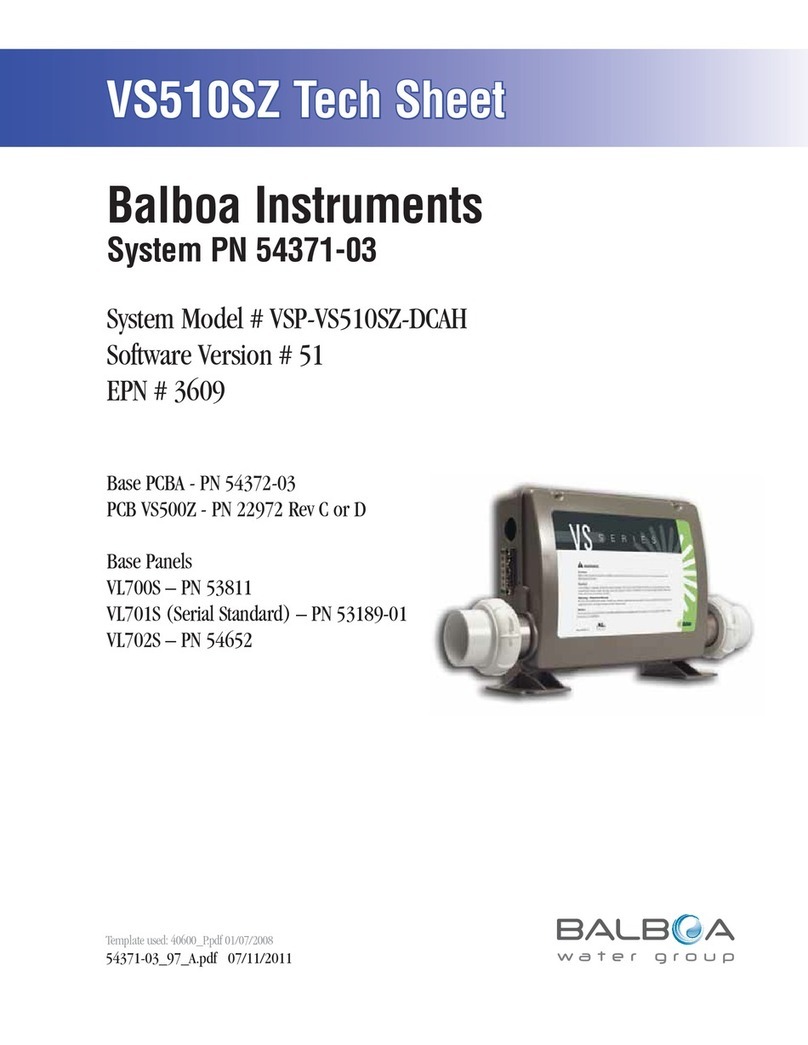
Balboa Instruments
Balboa Instruments VSP-VS510SZ-DCAH Tech sheet
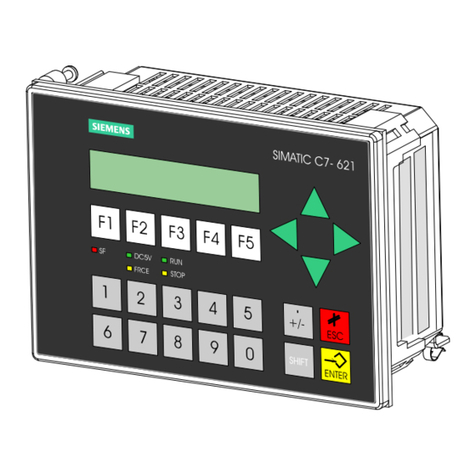
Siemens
Siemens simatic c7-621 Hardware installation guide

Carrier
Carrier AQUASNAP 30RA/RH Operation & maintenance instructions

Mazak
Mazak STX SC L PLUS CONTROL Training manual
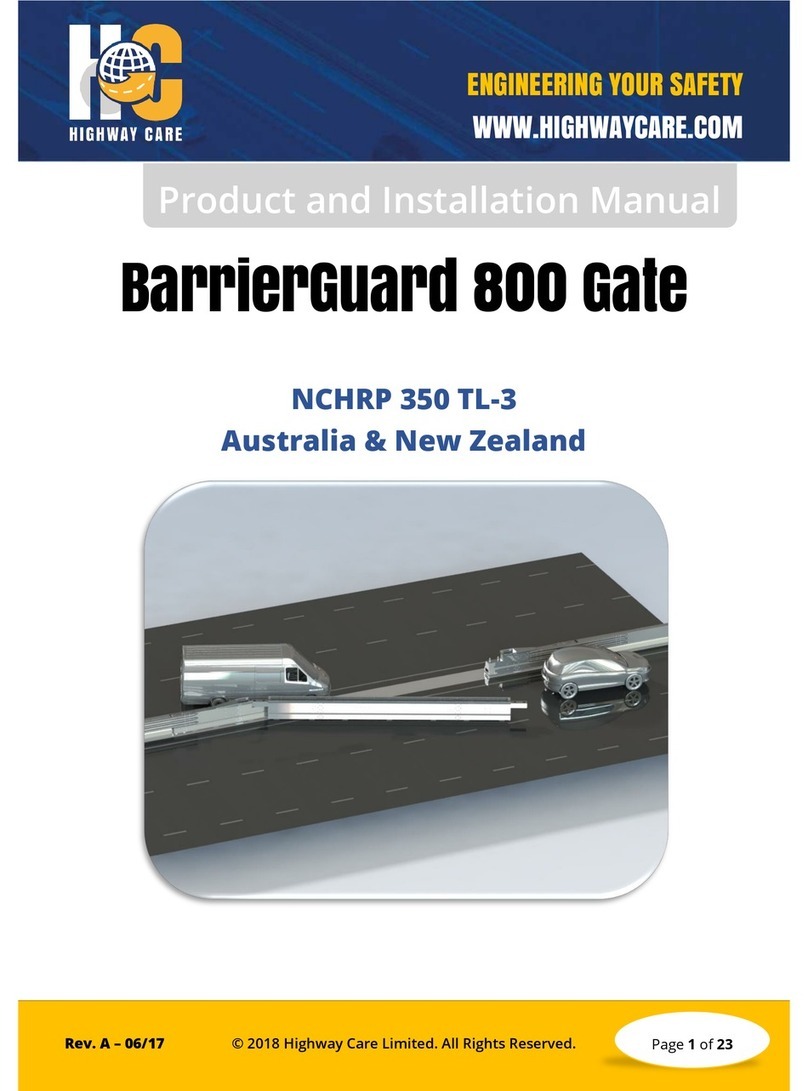
Highway Care
Highway Care BarrierGuard 800 Product and installation manual
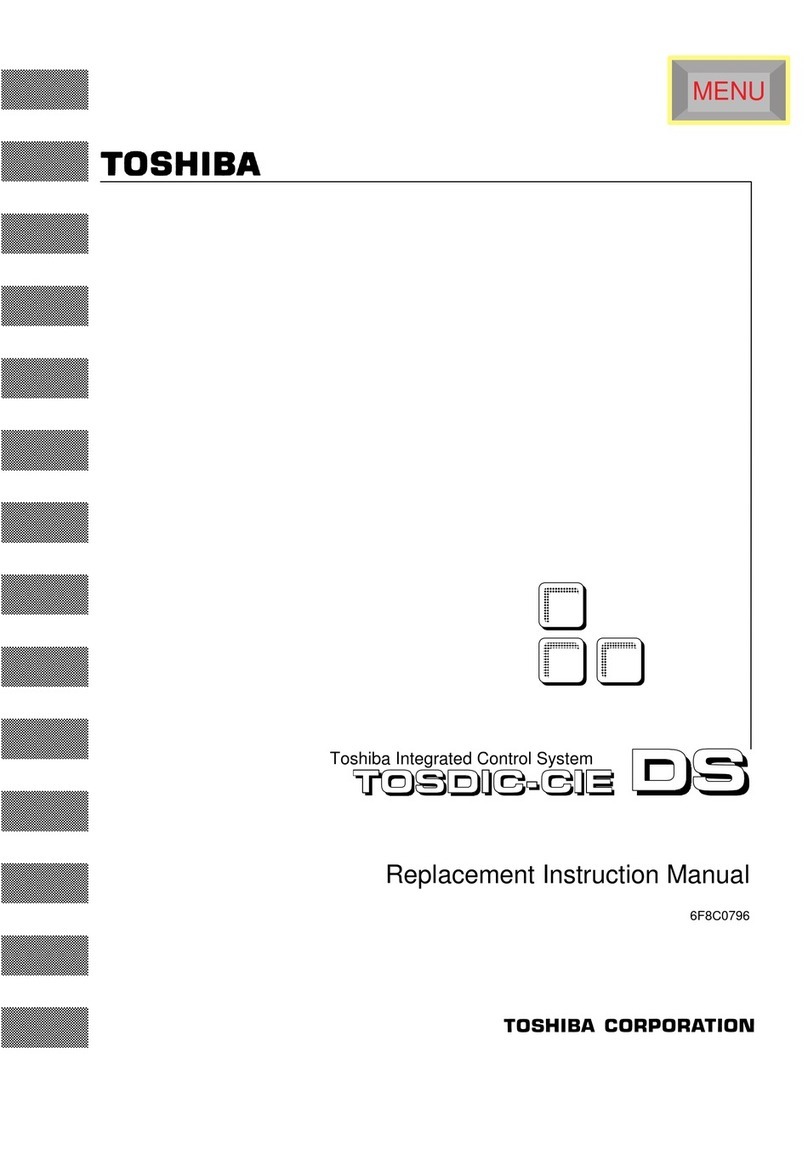
Toshiba
Toshiba TOSDIC-CIE DS instruction manual
